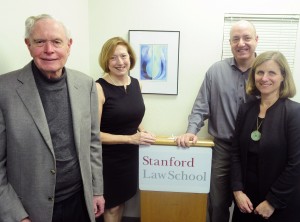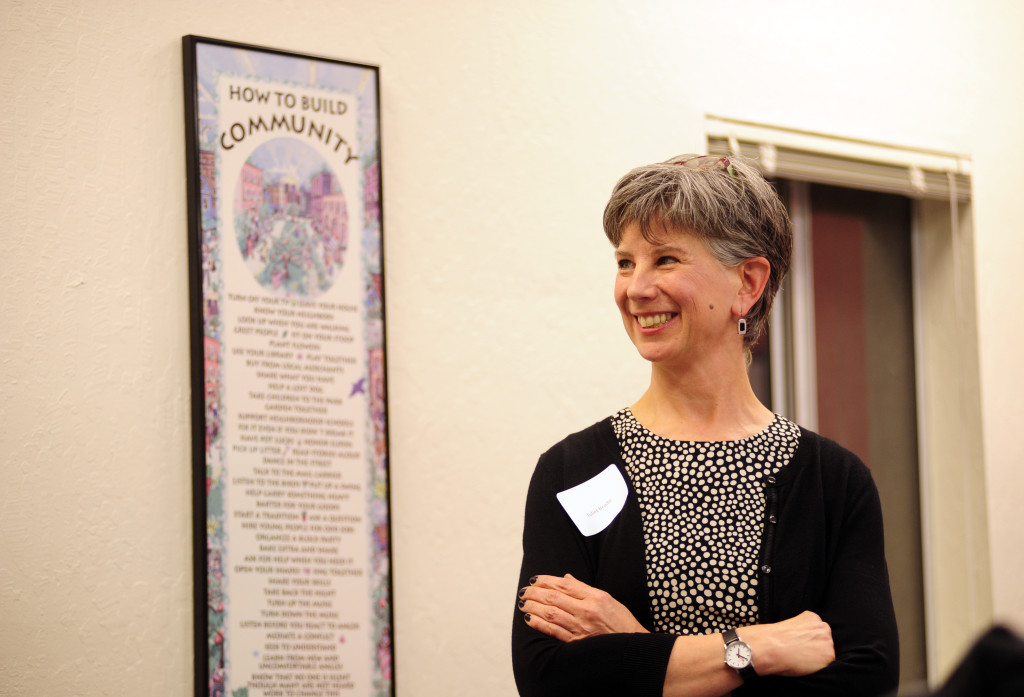SLS’s Community Law Clinic celebrates 10 years of service, dedicates newly renovated space

Stanford, Calif., November 5, 2013 – Supporters of Stanford Law School’s Community Law Clinic (CLC) gathered at its newly renovated headquarters in East Palo Alto on Monday night to help CLC celebrate its 10th anniversary. The renovation—CLC’s first major renovation in 10 years—represents an investment by SLS and Stanford University to maintaining a physical presence in East Palo Alto. And while the celebration included a dedication of the newly renovated facility, it was also a renewal of CLC’s resolute commitment to the community.
The Honorable Ruben Abrica, Mayor of East Palo Alto, presented CLC with a proclamation from the East Palo Alto City Council in honor of CLC’s “outstanding work.” And Sonja Spencer, Chair of East Palo Alto’s Rent Stabilization Board, presented CLC with a resolution from the Board commemorating CLC’s 10th anniversary.
CLC is determined to remain present in East Palo Alto. Such a presence is “absolutely vital,” said Juliet Brodie, Director of CLC and of the Mills Legal Clinic at SLS. “It represents that while we may be providing services, the community provides our home. It’s a two-way street.”

CLC’s twofold mission is decidedly unique. While all SLS clinics teach their students how to serve clients, CLC also serves a historically underserved community. Many low-income residents of East Palo Alto and the surrounding communities still struggle to get legal help with the most essential matters of daily living, such as housing and employment. CLC’s combined mission of pedagogy and location-based advocacy helps students “meet their clients where they are” said M. Elizabeth Magill, Richard E. Lang Professor of Law and Dean of SLS. The students are “advocating for their clients and learning to be extraordinary lawyers at the same time,” Dean Magill added.
The clinical program at SLS is one of the school’s most distinctive features. Students experience the full breadth of legal practice, but within a structured environment of supervision and encouragement to give back to the community. Students also perform their clinic work full-time, which allows them to immerse themselves in the study of solving real-world challenges on behalf of actual clients.
Although the mood on Monday night was jubilant, CLC was born during a time of crisis. Its predecessor, the student-founded East Palo Alto Community Law Project, shut its doors in 2003, leaving the community in danger of losing a critical source of legal representation. SLS’s leadership was acutely aware of this risk and undertook extraordinary efforts to ensure that SLS maintained its commitment to the residents of East Palo Alto and the surrounding communities. With the leadership of then-Dean Kathleen Sullivan and Professor David Mills, in whose honor the entire SLS clinical program is now named, the law school opened CLC.
Brodie launched the festivities by acknowledging Mills’ role in founding the clinic: “It is literally true that we would not be here today if David hadn’t stepped into the breach, and ensured that SLS continued to work in East Palo Alto. Every single student and every single client owes a debt to him for making sure these doors opened, and that they have stayed open.”

Since CLC opened its doors in 2003, it has served more than 1500 clients and trained more than 250 future attorneys.
“We are very proud to embody Stanford’s very concrete involvement in the communities that surround the campus, and to train SLS students in the noble tradition of providing legal services to those in need,” Brodie noted.
CLC typically represents individuals in eviction, wage and disability cases. For example, CLC recently represented a restaurant worker who was denied his wages when he left his job due to unbearable conditions. The employee, who was working long hours for far less than minimum wage, was required to live in a room with four other employees in the back of the restaurant and was sometimes refused the opportunity to take his medication. Because of CLC’s involvement, not only did the employee get his back wages, but he also received some money for his suffering.
CLC also played an important role in rebuffing a concerted, targeted attack on East Palo Alto’s rent-controlled housing stock. A few years ago, real estate investment firm Page Mill Properties acquired more than three quarters of East Palo Alto’s rental stock and issued massive rent increases to tenants virtually overnight. CLC successfully represented more than 125 tenants in what amounted to a class action before the city’s rent board. That success, combined with additional advocacy by CLC and others, paved the way for a settlement that helped set base rents and obtain refunds of rental overcharges. CLC then worked on amending East Palo Alto’s rent control law to prevent a recurrence of this incident.
Ultimately, the focus of CLC’s 10th anniversary celebration was its steadfast work in the community. At one point, Brodie held up a large green book and told the assembled crowd that the book contained a handwritten list of the 1500-plus clients served by CLC during its 10 years.
“It’s such an honor to have them with us … even symbolically,” Brodie said. “This is what it’s all about.”
About the Community Law Clinic Based in East Palo Alto, a low-income community four miles from the law school campus, the Community Law Clinic is the closest thing to a traditional legal services office among Stanford’s clinical offerings. The signature feature of the CLC is its off-campus location, which gives students the unique opportunity to work in a community-based, storefront, legal aid office. The office affords CLC students extensive client contact, as well as a feel for daily life in East Palo Alto, a small community whose residents are overwhelmingly people of color, and which has had for decades a poverty rate well above the national and state rates. The Clinic’s areas of focus are wage and hour, housing, and criminal record expungement matters, but the program’s practice areas shift in response to local threats and opportunities. The CLC also works on policy projects, legislative advocacy, and community legal education in areas that affect its clients.
About Stanford Law School
Stanford Law School is one of the nation’s leading institutions for legal scholarship and education. Its alumni are among the most influential decision makers in law, politics, business, and high technology. Faculty members argue before the Supreme Court, testify before Congress, produce outstanding legal scholarship and empirical analysis, and contribute regularly to the nation’s press as legal and policy experts. Stanford Law School has established a new model for legal education that provides rigorous interdisciplinary training, hands-on experience, global perspective, and focus on public service, spearheading a movement for change.
